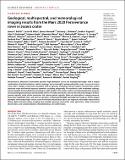Geological, multispectral, and meteorological imaging results from the Mars 2020 Perseverance rover in Jezero crater
Author(s)
Unknown author
DownloadPublished version (2.272Mb)
Publisher with Creative Commons License
Publisher with Creative Commons License
Creative Commons Attribution
Terms of use
Metadata
Show full item recordAbstract
<jats:p>Perseverance’s Mastcam-Z instrument provides high-resolution stereo and multispectral images with a unique combination of spatial resolution, spatial coverage, and wavelength coverage along the rover’s traverse in Jezero crater, Mars. Images reveal rocks consistent with an igneous (including volcanic and/or volcaniclastic) and/or impactite origin and limited aqueous alteration, including polygonally fractured rocks with weathered coatings; massive boulder-forming bedrock consisting of mafic silicates, ferric oxides, and/or iron-bearing alteration minerals; and coarsely layered outcrops dominated by olivine. Pyroxene dominates the iron-bearing mineralogy in the fine-grained regolith, while olivine dominates the coarse-grained regolith. Solar and atmospheric imaging observations show significant intra- and intersol variations in dust optical depth and water ice clouds, as well as unique examples of boundary layer vortex action from both natural (dust devil) and Ingenuity helicopter–induced dust lifting. High-resolution stereo imaging also provides geologic context for rover operations, other instrument observations, and sample selection, characterization, and confirmation.</jats:p>
Date issued
2022-11-25Department
Massachusetts Institute of Technology. Department of Earth, Atmospheric, and Planetary SciencesJournal
Science Advances
Publisher
American Association for the Advancement of Science (AAAS)
Citation
2022. "Geological, multispectral, and meteorological imaging results from the Mars 2020 Perseverance rover in Jezero crater." Science Advances, 8 (47).
Version: Final published version